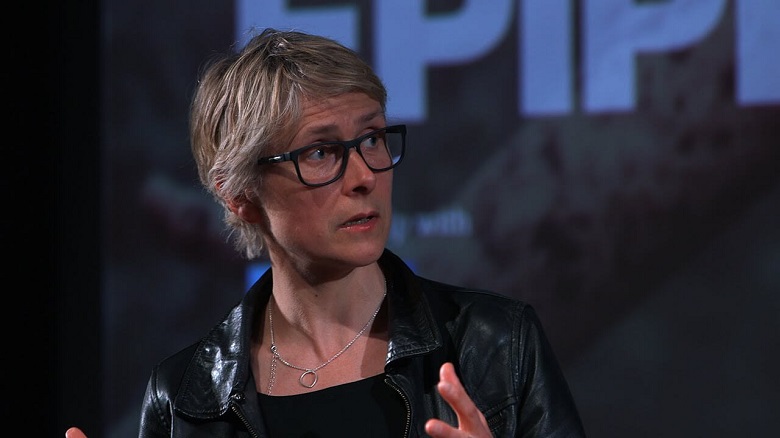
When it comes to directing, we all need help. From our cast, from our crew, from our designers. But what about for those less tangible aspects? Things like developing an approach to text analysis. Learning to effectively run a rehearsal room. Or even strategies for a crisis in confidence. Who can we turn to for help with these? The answer might just be Katie Mitchell. Mitchell has been labelled many things during her thirty-year career. A revolutionary. A feminist. An auteur. An egotist. Some consider her Britain’s greatest living theatre director. Others are less enamoured. Regardless of opinion, what isn’t in dispute is the intense way she goes about directing. This rigorous approach is documented in her seminal book ‘The Director’s Craft – A Handbook for the Theatre’.
And for anyone who wants to be (or even “is”) a theatre director, it really is essential reading.
“Early attempts at directing can flounder because directors do not have certain simple tools. Without these tools, directing becomes a process based on chance rather than skill.” – Katie Mitchell
The Director’s Craft is divided into three primary sections.
Sun Tzu, who wrote ‘The Art of War’, is credited as saying “Every battle is won or lost before it’s fought”. Mitchell is clearly an advocate of this principle. The scale of her preparation is beyond comprehensive. In fact, at times, it’s downright intimidating. However, her detailed approach to text analysis provides a definitive platform to assume authority over a production. The value of which, as any director will tell you, cannot be overstated.
Mitchell asserts the foundation for all directorial choices lays with identifying the facts of the play. Practically, this means making a list of everything explicitly stated in the text. Not what’s implied. Nor what is open to interpretation. Only what’s EXPLICITLY stated. As she does this, she’s also making a list of questions that arise from anything the facts don’t cover. By starting here, it frees the director from having to make creative decisions before they’re ready.
Once the facts are in place, Mitchell turns her attention to the many questions she has. They become the basis of her research into the world of the play. When she talks about research, however, she doesn’t mean a bit of generalised reading. She’s referring to an extensive investigation into every aspect of the text.
For example, her study of place extends far beyond just the play’s setting. It also includes research into the town or city the play’s located in, where that might be positioned in terms of other major hubs, and even the overall socio-political circumstances of the country itself.
Equally as important is the concept of time. Beyond simply time of day, Mitchell explores historical context, political context and how the passing of time shapes each scene.
She also prepares biographies for every character in the play, creating a chronological outline of all the key events that have shaped them. Traditionally, this has been considered the actor’s domain but Mitchell insists it’s also a directorial task. Which is then discussed and negotiated with the actors in rehearsals.
Next, Mitchell sets her sights on the “immediate circumstances”. Whereas identifying background facts involves listing everything prior to the play, immediate circumstances focus only on the twenty-four hours leading up to each scene. Discovering these follows the same process as compiling facts. Record what’s explicitly stated and write up everything else as questions to be researched. Mitchell’s entire MO is essentially list what’s known, question what’s not and research it.
Repeatedly.
Does it feel overwhelming?
Absolutely.
But this is the beauty of The Director’s Craft. It very clearly illustrates how much work the job of directing entails. There simply ain’t no shortcuts.
Mitchell’s next step is to address the play’s big ideas. First, she suggests reading through the text looking for an answer to one simple question. What is the play really about? Mitchell recommends coming up with a list of ten or so possibilities. From there, go back to the text and measure how many of the characters does this idea apply to?
If it’s the majority, it’s likely an overall part of the piece. If it’s just one or two character, it can probably be discarded. By the end, the director should land on about four keys ideas that become the foundation on which everything else is built.
At this point, Mitchell’s now ready to work directly on the scenes. She starts by giving all the acts a name (assuming the play is structured with acts), noting however, the importance of assigning names that relate to all cast members. This inclusive approach ensures everyone identifies with it. From here, she begins detailed work on the text using the concept of “events”.

Events, at their simplest, are a change in the action of the play. They could be, for example, the entrance of another character, the emergence of a new plot development or simply a shift in conversation. However, the simplicity of the description belies its difficulty in practice. Unlike the more ubiquitous “beats” commonly used by many directors that mark a change in topic, events are based purely on shifting character intention.
Such a breakdown provides both the actors and the audience with a much clearer structure with which to interpret the play.
“Events don’t just alter what the actors play, they also affect what the audience see and often the tempo of what happens. Using events to structure a play therefore makes things clear for the actor and the audience in equal measure.” – Katie Mitchell
As the director goes through each scene, Mitchell recommends circling each event and giving it a simple name. She also emphasises the importance of using neutral language to prevent any overt influence on the actors’ interpretation when it comes time to rehearse.
The next thing she does is interesting.
Once Mitchell has the events listed, she’ll then work out which one is the most important and label it “the main event”.She does this in order to prevent one of the biggest issues with the work of inexperienced (and even experienced) directors.
“Drawing one event up above the rest in an act or a string of scenes begins to help you sculpt the overall shape of the performance. One of the pitfalls in early attempts to directing is a leveling-out, in which all the moments in the action are given equal value by the performers. Instead, guide both the actors and audience to the most important events in the action.” – Katie Mitchell
The final step is to give all the action between events a clear intention. Naturally different characters will have different intentions, but Mitchell stresses that whatever the choice is for each actor, there are no changes between events. With these key mark-ups in place, there’s one final piece of the prep-puzzle to complete.
Mitchell’s last form of analysis involves taking a deeper look at the characters. She makes a list of everything each character says about themselves before boiling it all down to a simple “I am… ” phrase. For example, “I am a bad mother, poor, a great actress, ageing.”
Once she’s determined how each character sees themselves, she then repeats the process, but now identifying how they see the other characters. “He’s my son, a burden, unemployed, my baby boy, a parasite.” She reminds directors to not shy away from having conflicting statements about others as this reflects real life. And again, these should be distilled to a single phrase consisting of a noun and adjective.
So now, with hours of analysis ensuring the director understands the piece they’re directing, they’re ready to meet the production team.
Mitchell identifies 7 key relationships to be developed. These are:
Here she covers the scope of each area (for example, “design” includes set, props and costume) and explains their respective functions. She goes on to discuss how to establish clear communication channels with each of the specialised designers in order to effectively convey your ideas.
The final two chapters of Part One focus on casting and preparing the rehearsal environment. In terms of auditions, Mitchell likes to separate it into four stages:
Interestingly, she makes no mention of monologues but only refers to scene work from the actual play (preferably with someone else reading across from the actors). She also encourages questions from the actors, but warns directors to be prepared for this. Often queries such as ‘Why do you want to direct this play?’ will be put forward, and having a confident answer will ensure the actor feels assured they’re in safe (or at least “competent” hands).
To wrap up Part One of The Director’s Craft, Mitchell talks about the practical aspects of prepping for rehearsals, including working with a stage manager (one of the most crucial relationships a director will have), establishing communication structure and setting up the rehearsal room.
And now with all of the prep in place, the director is at last ready for rehearsals.

Also by Sheepdog Theatre:
What Do Audiences Want? Involving Audiences in Theatre Seasons
The Importance of An Authentic Theatre


Michael Walker has worked as an actor, writer and director in Japan, Australia, the UK and the US. His acting credits include commercials, television shows and feature films. He was also the founder of maidenagoya, Nagoya’s first foreign-led, independent theatre company. Amongst the numerous shows he directed was Martin Sherman’s Bent, and a bilingual version of Romeo & Juliet, which toured Tokyo after its Nagoya season. Along with his theatre work, Michael is an experienced screenwriter who has had films play at festivals around the world. He is currently living in Tokyo and is the Artistic Director of Sheepdog Theatre.
Read Full Profile© 2021 TheatreArtLife. All rights reserved.

Thank you so much for reading, but you have now reached your free article limit for this month.
Our contributors are currently writing more articles for you to enjoy.
To keep reading, all you have to do is become a subscriber and then you can read unlimited articles anytime.
Your investment will help us continue to ignite connections across the globe in live entertainment and build this community for industry professionals.